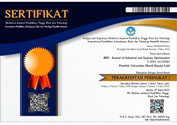PENDEKATAN SIX SIGMA UNTUK ANALISIS KUALITAS DI PT. KERAMIK DIAMOND INDUSTRIES
DOI:
https://doi.org/10.51804/jiso.v5i1.1-9Keywords:
DMAI, FMEA, Produk Cacat, Six SigmaAbstract
PT. Keramik Diamond Industries (KDI) merupakan perusahaan yang bergerak dibidang industri keramik dinding dan lantai. Dalam tahapan proses produksinya masih sering terjadi berbagai penyimpangan serta hambatan yang dapat mengakibatkan produk ubin keramik (tile) dianggap cacat. Produk tile yang dianggab cacat produksi berupa : gupil sesudah glaze, gupil sesudah bakar, gupil sebelum glaze, retak body dan kotor affal. Sebagai upaya untuk menurunkan produk cacat yang terjadi di PT. KDI maka perlu dilakukan pengendalian kualitas dengan menggunakan metode six sigma dengan DMAI untuk meningkatkan kualitas produksi. Dalam tahap define terdapat 5 jenis cacat produk yang terjadi. Pada tahap measure diperoleh produk cacat tertinggi pada cacat gupil sesudah glaze sebesar 19.398 pcs/ 35,47 % dan nilai DPMO sebesar 12.741 pcs dengan sigma level sebesar 3,8 sigma. Dari hasil analisis diperoleh faktor – faktor pemicu terjadinya cacat produk tile antara lain adalah faktor manusia, mesin, metode, material dan lingkungan. Berdasarkan analisis tersebut usulan perbaikan dapat diketahui dari hasil nilai RPN tertinggi.
ABSTRACT
PT. Keramik Diamond Industries (KDI) is a company engaged in the wall and floor ceramic industry. In the stages of the production process, deviations and obstacles often occur which can result in ceramic tile products being considered defective. Tile products that are considered to be defective in the form of: chipped before glazing, chipped before burning, chipped before glazing, cracked body and dirty affal. As an effort to reduce defective products that occur in PT. KDI then need to do quality control using the six sigma method with DMAI to improve production quality. In the define stage there are 5 types of product defects that occur. At the measurement stage, the highest defective product was found in the gupil defects before glaze of 19,398 pcs/ 35,47 % and the DPMO value of 12,741 pcs with a sigma level of 3.8 sigma. From the results of the analysis, the factors that trigger the occurrence of product defects include human, machine, method, material and environmental factors. Based on this analysis, the improvement proposal can be seen from the results of the highest RPN value.
References
Amrullah, Siburian, P. S., & ZA, S. Z. (2016). Pengaruh Kualitas Produk dan Kualitas Layanan Terhadap Keputusan Pembelian Sepeda Motor Honda. Kinerja : Jurnal Ekonomi Dan Manajemen, 13(2), 99–118. Retrieved from http://journal.feb.unmul.ac.id/index.php/KINERJA/article/view/826
Ardhyani, I. W., & Santoso, S. (2020). Analisis Cacat Produk Kemasan Wafer Di Pt. Tkt Mojokerto. Teknika: Engineering and Sains Journal, 4(2), 43.https://doi.org/10.51804/tesj.v4i2.877.43-48
Bonar, H., Luthfi, P., & An, A. L. F. (2018). Analisis Pengendalian Kualitas dengan Menggunakan Metode Six Sigma ( Studi Kasus : PT. Growth Sumatra Industry ). Jurnal Buletin Utama Teknik, 13(3), 211–219.
Cesaron, D., T. (2015). Penerapan Metode Six Sigma Dengan Pendekatan Dmaic Pada Proses Handling Painted Body Bmw X3 (Studi Kasus: Pt. Tjahja Sakti Motor). Jurnal PASTI, IX(3), 248–256.
Kusumawati, A., & Fitriyeni, L. (2017). Pengendalian Kualitas Proses Pengemasan Gula Dengan Pendekatan Six Sigma. Jurnal Sistem Dan Manajemen Industri, 1(1), 43. https://doi.org/10.30656/jsmi.v1i1.173
Ratnadi, & Suprianto, E. (2016). Pengendalian Kualitas Produksi Menggunakan Alat Bantu Statistik (Seven Tools) Dalam Upaya Menekan Tingkat Kerusakan Produk. Indept, 6(2), 10–18.
Sirine, H., Kurniawati, E. P., Pengajar, S., Ekonomika, F., Bisnis, D., & Salatiga, U. (2017). PENGENDALIAN KUALITAS MENGGUNAKAN METODE SIX SIGMA (Studi Kasus pada PT Diras Concept Sukoharjo). AJIE-Asian Journal of Innovation and Entrepreneurship, 02(03), 2477–3824. Retrieved from http://www.dirasfurniture.com
Downloads
Published
Issue
Section
License
With the receipt of the article by JISO Editorial Board and the decision to be published, the copyright regarding the article will be transferred to JISO. The copyright transfer form can be downloaded here.
JISO has the right to multiply and distribute the article and every author is not allowed to publish the same article that was published in this journal.
JISO is licensed under a Creative Commons Attribution-ShareAlike 4.0 International License.
Under the following terms:
Attribution — You must give appropriate credit, provide a link to the license, and indicate if changes were made. You may do so in any reasonable manner, but not in any way that suggests the licensor endorses you or your use.
ShareAlike — If you remix, transform, or build upon the material, you must distribute your contributions under the same license as the original.














